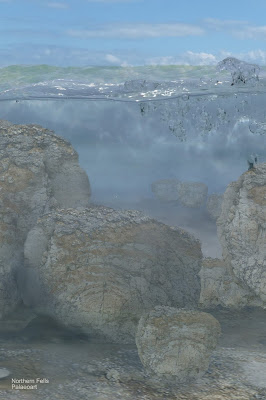After my two prior pieces of digital artwork depicting Precambrian stromatolites, - click here- & - click here -, I decided to continue along the theme. This time, however, I decided to go with portrait pieces. This raised some challenges, as stromatolites, generally lend themselves to landscape artworks as, they form large sheets/ expanses of bioherms. Portrait pieces do though, allow for somewhat more interesting compositions, with greater areas of sea and sky- portraying more of the general landscape.
 |
| A general plan for some ideas. |
Above is a general plan and some ideas for digital reconstructions. This plan was scribbled down at 3am, and is the first digital piece with forward planning; as the other two prior pieces were created without any planning of the composition.
 |
| Precambrian Stromatolite Digital Reconstruction III. (I need to come up with something a bit catchier!) |
The final piece is composed of individual bioherms- these were made from the 2D rock face and copious amounts of shading to mimic the true shape.
Added onto the top is a photo of contemporary stromatolites, representing the upper growing surface. As the living stromatolite's colour is more green/brown than the Precambrian counterpart, I introduced the colour to the rest of the structure through a transparent layer as well as less transparent, and more noticeable layers (characteristic of the structures).
My next reconstruction, I had decided, was going to be different. The benefit of looking through water is that due to refraction and the opaque quality, numerous sins can be hidden. If there is a edge that looks out of place- simple- put a wave or more opaque patch of water over the top. For my next piece I wanted to transition below the water.
 |
| My water tank set-up. |
To do this, I needed more photographs. I was limited by the photographs of water that I had taken in the past. To be able to make a photogenic and natural transition between air and water I had to take a series of new photos of that exact transition. To do this I set up a water tank (above). I initially set up the water tank at the back of the house, but this lead to poorly lit and out of focus images (below).
 |
| Poorly lit and inadequate photographs. |
I then decided to take it out into the direct sunlight at midday. I hoped this would create a better effect, especially with the added light. I took the images by putting my camera on a tripod and agitating the water by adding water with a small watering can. This meant that the photographs varied considerably from numerous bubbles where the water spout met the main body of water to simple waves where the water from the can ceased.
 |
| The water tank setup - note the water spout from the can at the top. |
 |
| Photographs of the water tank in the sunlight (before the sun clouded over). |
With these photographs, I created an image, using the same stromatolite bioherms as the previous image, underwater.
 |
| Precambrian Stromatolite Digital Reconstruction IV. |
I was please with the image, however, in the future I would like to play around a bit more with the bubbles and moving water, perhaps indicating movement through the stromatolite runnels.
One key issue with stromatolitic reconstructions is that, in their nature, they are not particularly dynamic. Hence,the setting and composition is even more important, than say your typical dinosaur palaeoart.
Further sources on the Precambrian stromatolites:
A Guide to the Geology of Islay (2015), by Webster, Anderton and Skelton is a fantastic guide to the geology of the island, with particular emphasis on walking and visiting localities of interest: a must have.
The Late Precambrian Geology of the Scottish Highlands and Islands: No.44 Geolgists' Association Guide (Geologists' Association Guides) (1991) by Hambrey et al. includes a good number of excursions including to the north of Islay, where further detail is given: a good companion to the above guide.
The Dalradian rocks of the south-west Grampian Highlands of Scotland (2013) by Tanner et al.
Plus other publications by Fairchild and Spencer & Spencer detailing the Bonahaven Dolomite and it's stromatolites.




Comments
Post a Comment